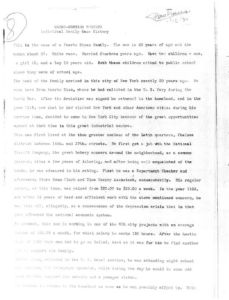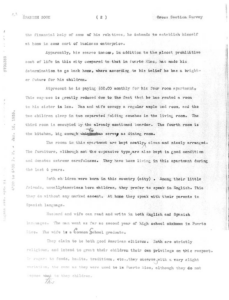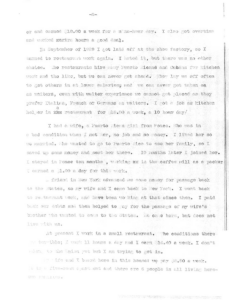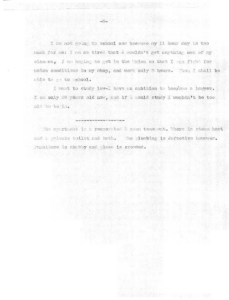Testimonios of the Depression
The Works Progress Administration interviews in New York City’s Hispanic Community in the late 1930s provide a gold mine of voices of Puerto Rican and Latino migrants. The WPA sponsored massive research projects in the US’s regional, ethnic/racial, and immigrant cultures. The research materials on Hispanics were gathered towards a book, The Spanish Book, that was never published. I made these syntheses from the interviews to offer a window into how Puerto Ricans experienced the Depression. WPA interviews do not provide the full name of the interviewee. Sometimes, they refer to the person with their initials and sometimes by a number.
A plumber from Santurce who ended up working at the National Biscuit Company could only find erratic jobs “working when and wherever,” which also meant moving to the worse tenement conditions of Spanish Harlem. He and his family “suffered horribly.” A charity organization helped him for a year before he found himself working as a porter for $22/week. He then found work at an automat at $24/week but lost this job when he got sick. He then worked as a dishwasher, while one of his children died. Finally, while unemployed, he got into the city’s WPA-funded relief program in 1937. He was proud, saying, “I manage to carry on the burden of keeping my family away from starvation.”
One Depression-era migrant who arrived in 1934 was more upbeat about conditions by 1938: “Now I feel much different. Hope I never have to go back home; at least, while I can make a decent living here in the States and can afford to take care of my family.” Another story of marginal improvements came from a trained carpenter, also from Santurce, who traveled to New York as a mess boy on a ship and then started as a $14/week dishwasher working 10-hour days, six days a week, somehow still managing to bring his family up from the island. He then worked nights as a cook, making $20/week, feeling “more ambitious” now that his family had joined him, even managing to buy furniture on terms. But his conditions improved further with a promotion to first cook and the arrival of union Local 302 of the Hotel and Restaurant Employees Union. With wages of $35/week, they managed to save some money while still living in a tenement in bad conditions in East Harlem.
Another educated child of modest farm owners in Fajardo migrated after family tragedy devastated his resources. At first, he found work at the Eveready battery factory doing clerical work for $15/week. His work life was sent into a spin with the Depression, which brought on unemployment. He then took work “wherever,” including in a garage, washing cars for $22/week, and then driving a taxi. For two years he had “not had a decent job,” so he managed to get relief payments, having no luck finding alternative employment. Another migrant decided New York offered better possibilities, given the “alarmingly depressing” conditions on the island once the Depression started. In New York he worked with friends who owned a moving van, but work was irregular and earnings low, $13 to $20. When his friend leased him a new truck, he did well even through the early years of the Depression, which meant working very long days moving many evicted tenants. But when conditions improved his clients stopped moving, and he was forced to apply for relief in 1936. After two months his application was accepted but only because of the support of the Communist Party-led Harlem Workers Alliance Unemployment Committee. Three years later he and his family still relied on relief payments and his irregular “odd jobs.”
An early migrant who was a WWI US Navy veteran with a high school education had settled in NYC in 1919. He first worked as a “common laborer” at the National Biscuit company, like so many other recent arrivals. Because of his skills he quickly advanced from production to clerical work, increasing his average wage from $22/week to an excellent rate of $35/week. But he was laid off in 1933, after 14 years at the plant. To survive, he received Relief payments from the city during the “hectic” deep Depression years and eventually got a WPA job with a city construction project for $56/month.
From Maricao, an apprentice baker with high school studies migrated in 1928 soon after his parents died. $35 for bakery workers was the reputed weekly wage that a migrants, making only $6-9/week on the island, could find attractive. His first jobs as a pantry man in the Hotel Commodore earned him $55/month but did not last long. Long 12-hour days at a cafeteria earned him $15 and $19/week, and he could not finish his high school degree studying at night. A shoe factory in Brooklyn shortened the work day for the same wages and allowed overtime work. With the Depression, a downward spiral began with his job as a kitchen helper for $18/week. “Restaurants hire many Puerto Ricans and Cubans for kitchen work and the like, but we can never get ahead…They lay us off often to get others in lower salaries and we can never get taken on as waiters, even with waiter experience we cannot get place as they prefer Italian, French or Germans as waiters.” After a brief return to Puerto Rico to see how things turned out he returned to New York with his wife. A new restaurant job in “terrible conditions” paid only $14.40/week he found no time for night school because he was “so tired that I couldn’t get anything out of my classes” with the promise of bringing a union to the restaurant to reduce the work day and hopefully “be able to go to school.”
A coffee picker from Coamo left Puerto Rico because life was “very hard.” He did hotel and restaurant work, and when the Depression hit, “many illusions concerning the advantages of living in a big modern city vanished somewhat.” He was forced to shift from one hotel to another until he became unemployed, with brief stints in public work with the WPA and relief. Joining the Workers Alliance also helped secure clothes for his family, and the City’s Harlem Hospital provided free care for his kidney trouble.
One worker had picked tobacco on the island since childhood. As a kitchen helper at a New York hotel, he made $13/week with meals, followed by a bus boy job when the Depression started, moving from cafeteria to cafeteria: “I am far from lazy, the best I can anywhere is bus boy, I can be dishwasher, or kitchen helper in a hotel, but beyond that I don’t get.” When interviewed in 1937, he was a member of Local 302 of the Cafeteria Employees Union, earning $15/week plus meals. Supplementary relief of $20/month helped with his family expenses, and he still felt he was better off than in Puerto Rico.
R.P. grew up in San Sebastian and migrated to New York in 1926 because he had, “suffered too much there,” working in Santurce’s tobacco factories and then doing housework “at starvation wages” (“I never want to go back”). But things in New York “haven’t been much better.” Unemployed since 1931, and on relief with $12/week, he worked on and off jobs in factories and laundries. He then joined the Workers Alliance (“if we don’t fight, no one will fight for us”).
The son of a poor baker from Cayey, ECS emigrated in 1919 after learning cigar-making. His wife and children died from disease on the island where “there was never enough to eat.” During the 1920s, he found plenty of work earning $30/week and sometimes even $40. During the long 1919 strike he had to work at the Hotel Astor wiping plates and serving food for two months. A stay in Tampa in 1930 led to eventual unemployment, and a return to New York, then Scranton, where he worked at a nonunion mechanized tobacco plant in which seven traditional cigar makers performed skilled work alongside 200 women producing a machine-made product. A suction machine “which could be operated by women” replaced him eventually, and a return to the City kept him making cigars at a small scale with “very poor” pay—eventually he forced to apply for relief. Like many PR cigar makers, he was a member of the Mella Club.
A self-described clerk and unlicensed doctor had his wife ordered to a colder climate for health reasons in the late 1920s. His first job at the Merrill spring factory as a machine shop, and then as a machinist, earned him $22/week with long hours of mandatory overtime. Lack of rest led him to a different job in an elevator manufacturing shop where he became a foreman to 25 workers but earned only $19/week. He then held ten different jobs in 18 months, all in metal factories, followed by unemployment—he and his family were starving without relief. The Salvation Army and Catholic Charities gave him food, but only for a while, and then his relief was approved. A taxi driver’s license later led to an income driving, but he could not support his family on what he made and had to go back on relief twice .
A baker’s apprentice migrated and found work at the hotel commodore as a pantryman making $13/week, and later 12-hour days at cafeterias for $15 and $17. After a brief return to Puerto Rico he returned to restaurant work under the same conditions, but he had his hopes fixed “trying to get the union interested in the place so that we can better our conditions.”
Those who managed to hold on to their jobs or higher incomes were usually in higher-skill positions, had more formal education, and had learned English early. After working at National Biscuit since the mid-1920s, one worker kept his high-paying job through the 1930s. He learned radio repair in preparation for the arrival of TV technology. Another worker, an orphan who completed high school in Santurce, also found relative success during the 1930s. He migrated in 1931 and found much work as a “Cuban musician” for which there was a constant demand. He worked steadily as a trumpet player, making $40/week by 1939. He also composed music for other recording artists. In the interview, he showed pride that his wife, an “American from Arizona,” worked only in their Spanish-speaking home, “as long as I can afford it.”
A man from Aguadilla was a trained accountant. Migrating in the midst of the Depression, he encountered trained accountants doing clerical work for little money, “if not washing dishes.” His first job was in the laundry of a hotel for $16/week which increased to $21 after 5 years. But his accounting skills kept him busy on his own time, earning another $26/week, which made for a “decent” living. For him, “Puerto Ricans who come to this city and return to the homeland usually exaggerate about the prosperous conditions existing here. According to them, there was a job in every business house just waiting for you; rent, food and clothing very cheap. I certainly regret that I made the mistake to come to New York.”
A San Juanero who migrated in 1936 had inherited a small cigar shop in Humacao from his father where he learned the trade and made a decent living, “not a get rich business.” But he blamed the Porto Rico American Tobacco which “put the shop out of business as they monopolize tobacco plantations.” After he migrated to San Juan, he began work at its largest cigar factory. After one year of hard work he sent for his family. After they migrated to New York he ran his own small shop of cigars and sold the product himself to shops and restaurants. He made $23/week, a decent wage for the Depression years, supplemented by his wife’s meager $6/week making flowers, lamps, and blouses at home.
Next: Labor Organizing in the 1930s
The text is copyrighted by the author, 2025.
Users may cite with attribution.




